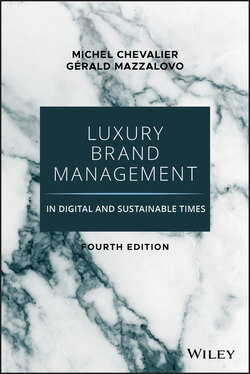Читать книгу Luxury Brand Management in Digital and Sustainable Times - Michel Chevalier - Страница 27
Eccentric Luxury
ОглавлениеLet's position luxury as a differential with respect to a standard. Can the conditions of this eccentricity be specified? What norms or standards will real luxury brands break from?
For Jean-Marie Floch, the foil is the natural mercantile attitude seeking the optimization of profits in the short term. In fact, anything that is driven by logics of mass markets should remain outside of the realm of luxury: Is the consumer not seeking there, precisely, signs of distinction?
A definition from Jean-Louis Dumas-Hermès (late chairman of Hermès), reported by Lallement, goes in the same direction: “luxury brand is one that manages to meet three conditions: designing beautiful objects; choosing the consumer as the best vector of communication; and finally, deciding freely.”20 What a great formula! Beauty; clients as heralds of the brand; and, finally, freedom, where we meet again with the refusal of the overall economic logics.
Designing beautiful objects is not the exclusive domain of luxury anymore (think of the design of Ikea, Conran, etc.), and the concept of beauty is subjective. Choosing its consumer as a main vector of communication is already a most sought-after strategy, including for brands that aspire to lifestyle status. But it applies in areas other than luxury, for example, in the activation of social networks on the Internet.
We are left with the third part of the Dumas-Hermès statement: freedom. This independence from constraints, standards, and habits is the prerogative of a luxury that is defined by something extraordinary, a meaningful and relevant differential gap. The luxury product distinguishes us from others; it is a sign of being exceptional and freed (with respect to specific norms). Similarly, it should be distributed and promoted in an outstanding manner reflecting somehow this freedom.
Deviation from Norms. Such would be the essence of luxury, the basis for most of the definitions we have seen, for both the productive and perceptual types.
Luxury is not only the denial of mass mercantilism, but also the refusal of certain norms, within the meaning of a convention accepted by the greatest number, a positioning reflecting the distinctive character of luxury as highlighted by sociologists. The antithesis of a standard, luxury will be rare, elitist, expensive, beautiful, original, surprising, superfluous, refined, creative, inaccessible, representative of authority, and so on. Everything will depend on the chosen norms and on the type of perceived deviation.
If one accepts this definition as the “mother” of all the others, the implications are many. Each brand will have to set its own luxury, that is, the way to be competitive as a luxury brand, specifying both the norms it intends to depart from and the differentials on which this gap will rely.
In fact, most major luxury brands carefully cultivate their originality (i.e. their differentials), which they often develop in several directions at a time: a way for them to express luxury, but also to affirm the richness of their identity. This ability to mark its difference may characterize a luxury brand only if it is accompanied by a positioning on the right side of the semiotic square of consumption values: playing on the logics of desire and pleasure, respectively activating myths and dreams as well as fun and aesthetics.
Consider the case of Ferrari: the prestigious manufacturer used to be known to limit the number of vehicles it produced each year. From 2007 to 2017, the number of cars manufactured was oscillating between 5,000 and 7,000 cars per year. This Malthusianism was first a guarantee of exclusivity for the happy (few) customers of the brand. Since 2017, the policy has been altered and the volume of cars manufactured increased to around 8,500; the number of cars shipped was 10,131. It introduces also a spectacular difference from Porsche, its reference competitor, which shipped 280,800 vehicles in 2019. The other “luxury” of Ferrari obviously rests on its almost-century-old presence in the circuits of international motor racing and especially in Formula 1. Since 1950, the Scuderia Ferrari has won 238 Grand Prix races, 16 Constructor World titles, and 15 Drivers' World titles. It is a euphemism to say that the amateurs of exceptional automobiles dream about Ferrari cars: in 70 years of existence, the brand has been able to jealously preserve its status as a myth. The absolute differential belongs to the winner with respect to all the other (defeated) competitors.
The glassmaker Daum cultivates its difference by being the only European brand to produce “pâte de cristal” using the lost wax method. Its history is intimately linked to that of the Arts décoratifs and l'Ecole de Nancy in the early twentieth century. Daum appears, in this regard, to be a good example of these traditional luxury brands relying on a glorious past often linked to an artistic movement. It is an asset with which younger competitors can hardly compete; however, the prestige of tradition alone is not enough to guarantee the relevance or today's competitiveness of Daum's product offering.
